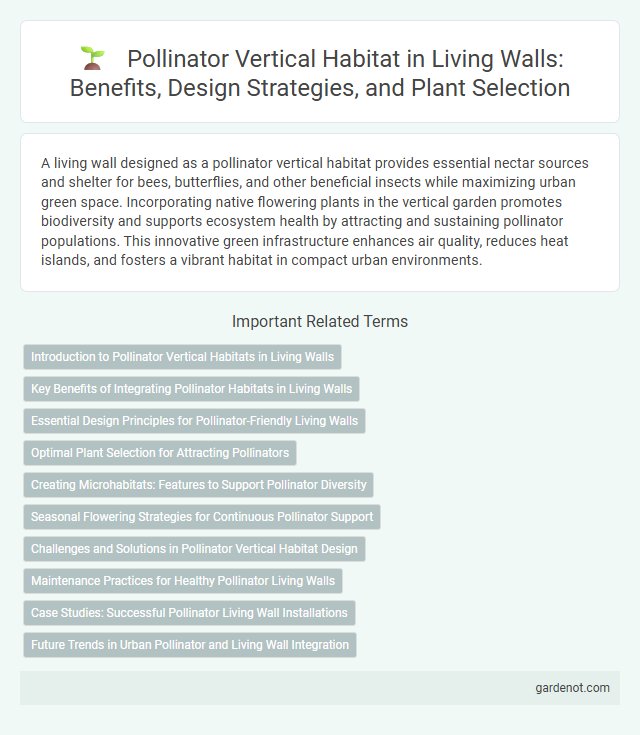A living wall designed as a pollinator vertical habitat provides essential nectar sources and shelter for bees, butterflies, and other beneficial insects while maximizing urban green space. Incorporating native flowering plants in the vertical garden promotes biodiversity and supports ecosystem health by attracting and sustaining pollinator populations. This innovative green infrastructure enhances air quality, reduces heat islands, and fosters a vibrant habitat in compact urban environments.
Introduction to Pollinator Vertical Habitats in Living Walls
Pollinator vertical habitats in living walls provide essential spaces for bees, butterflies, and other pollinators to thrive in urban environments. These habitats incorporate native flowering plants that support pollination and biodiversity while enhancing air quality and aesthetic appeal. Integrating pollinator-friendly species into vertical gardens promotes ecosystem health and aids in sustaining local pollinator populations.
Key Benefits of Integrating Pollinator Habitats in Living Walls
Integrating pollinator habitats in living walls enhances urban biodiversity by providing essential nectar sources and nesting sites for bees, butterflies, and other pollinators. These vertical gardens improve air quality and support ecosystem resilience while promoting natural pollination that benefits nearby plants and crops. The increased pollinator activity also contributes to vibrant, healthy green spaces, boosting environmental sustainability and aesthetic appeal in urban settings.
Essential Design Principles for Pollinator-Friendly Living Walls
Designing pollinator-friendly living walls requires incorporating diverse native flowering plants to provide continuous nectar and pollen sources across seasons. Optimize wall orientation and light exposure to ensure optimal growth and accessibility for bees, butterflies, and other pollinators. Integrate microhabitats such as small cavities and moisture-retaining substrates to support nesting and hydration needs for a thriving pollinator vertical habitat.
Optimal Plant Selection for Attracting Pollinators
Selecting native flowering plants such as milkweed, coneflowers, and bee balm ensures an abundant nectar source for pollinators in vertical habitats. Incorporating a diversity of bloom times maximizes continuous food availability, supporting bees, butterflies, and hummingbirds throughout the growing season. Plants with varied flower shapes and colors enhance attraction and accommodate different pollinator species' feeding mechanisms.
Creating Microhabitats: Features to Support Pollinator Diversity
Creating microhabitats within a pollinator vertical habitat involves integrating diverse flowering plants, nesting materials, and water sources to attract and support various pollinator species. Incorporating native plant species with staggered blooming periods enhances continuous food availability, promoting pollinator diversity throughout the seasons. Structural elements such as hollow stems and small cavities provide essential nesting sites, crucial for solitary bees and other beneficial insects.
Seasonal Flowering Strategies for Continuous Pollinator Support
Seasonal flowering strategies in pollinator vertical habitats ensure a diverse range of bloom periods that provide continuous nectar and pollen sources throughout the year. Selecting native flowering species with staggered peak blooming times maximizes habitat attractiveness for various pollinators, including bees, butterflies, and hummingbirds. Incorporating perennials, annuals, and biennials tailored to local climate zones enhances the living wall's effectiveness as a sustainable pollinator support system.
Challenges and Solutions in Pollinator Vertical Habitat Design
Designing pollinator vertical habitats faces challenges such as limited plant diversity, inadequate microclimates, and insufficient nesting sites, which can reduce habitat effectiveness for bees and butterflies. Solutions include selecting native, nectar-rich plant species, integrating varied structural layers to create microhabitats, and incorporating vertical nesting modules to support diverse pollinator populations. Optimizing irrigation systems and ensuring exposure to sunlight further enhance the viability and ecological benefits of pollinator living walls.
Maintenance Practices for Healthy Pollinator Living Walls
Regular pruning and careful removal of dead or diseased plant material maintain airflow and reduce pest infestations in pollinator vertical habitats. Irrigation systems should deliver consistent moisture without oversaturation to support diverse pollinator-attracting plants like native wildflowers and flowering herbs. Monitoring for invasive species and applying organic pest control methods ensure a thriving and balanced ecosystem that sustains pollinator health.
Case Studies: Successful Pollinator Living Wall Installations
Pollinator living walls have demonstrated significant ecological benefits in urban environments, exemplified by case studies such as the CaixaForum in Madrid and the Singapore Botanic Gardens. These vertical habitats support native bee populations and increase local biodiversity by integrating flowering plants that provide essential nectar and pollen resources. Data from these installations reveal a 30-40% rise in pollinator activity, highlighting the effectiveness of living walls in enhancing urban ecosystem services.
Future Trends in Urban Pollinator and Living Wall Integration
Future trends in urban pollinator and living wall integration emphasize enhancing biodiversity by incorporating diverse native flowering plants that support essential pollinator species such as bees, butterflies, and hummingbirds. Advanced sensor technology and IoT devices optimize microclimates within vertical habitats, improving plant health and pollinator attraction in dense urban areas. Sustainable design practices prioritize modular, easy-to-maintain living walls that contribute to urban green infrastructure, boosting ecosystem services like air purification and pollination.
Pollinator vertical habitat Infographic

 gardenot.com
gardenot.com